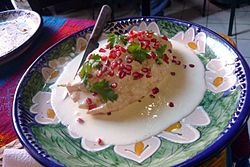 Chile en nogada prepared for serving | |
| Type | Stuffed vegetable |
|---|---|
| Course | Main |
| Place of origin | Mexico (1821) |
| Region or state | Puebla |
| Serving temperature | Room temperature |
| Main ingredients | poblano chile, picadillo, walnuts, cream, pomegranate |


Chiles en nogada is a Mexican dish of poblano chiles stuffed with picadillo (a mixture usually containing shredded meat, aromatics, fruits and spices) topped with a walnut-based cream sauce called nogada, pomegranate seeds and parsley, and it is typically served at room temperature. It is widely considered a national dish of Mexico.[1]
The picadillo usually contains panochera apple (manzana panochera), sweet-milk pear (pera de leche) and criollo peach (durazno criollo). The cream sauce usually has milk, double cream, fresh cheese, sherry and walnut. The walnuts, which give the nogada sauce its name (nogal being Spanish for "walnut tree")[2] are traditionally of the cultivar nogal de Castilla (Castilian walnut). In some cases, pecans may substitute for or supplement the walnuts.
This dish is made in Central Mexico in August and the first half of September, when pomegranates are in season.[3] The colors of the dish—green chile, white sauce, red pomegranate—are the colors of the flag of Mexico,[4] and Independence Day is during the pomegranate season.
- ^ Martinez, Rick A. (September 9, 2019). "Sweet, Salty, Sour, and Part of Mexico's Soul: Chiles en nogada — stuffed poblano peppers topped with a creamy walnut sauce and pomegranate seeds — makes a brief but grand appearance every September for the country's Independence Day". New York Times. Retrieved September 13, 2022.
- ^ "Nogal". Diccionario de la lengua española. Real Academia Española.
- ^ Graber, Karen Hursh (1 January 2006). "Pomegranates: September's Gift To Mexican Cuisine". MexConnect. Retrieved 2 February 2012.
- ^ Graber, Karen Hursh (1998). Take This Chile and Stuff It: Authentic Chile Relleno Recipes. American Traveler Press. pp. 26–27. ISBN 9781885590398.